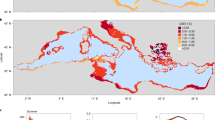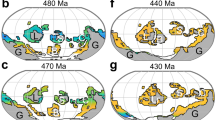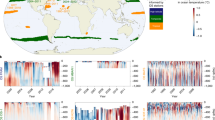Abstract
Inland standing waters are particularly vulnerable to increasing water temperature. Here, using a high-resolution numerical model, we find that the velocity of climate change in the surface of inland standing waters globally was 3.5 ± 2.3 km per decade from 1861 to 2005, which is similar to, or lower than, rates of active dispersal of some motile species. However, from 2006 to 2099, the velocity of climate change will increase to 8.7 ± 5.5 km per decade under a low-emission pathway such as Representative Concentration Pathway (RCP) 2.6 or 57.0 ± 17.0 km per decade under a high-emission pathway such as RCP 8.5, meaning that the thermal habitat in inland standing waters will move faster than the ability of some species to disperse to cooler areas. The fragmented distribution of standing waters in a landscape will restrict redistribution, even for species with high dispersal ability, so that the negative consequences of rapid warming for freshwater species are likely to be much greater than in terrestrial and marine realms.
This is a preview of subscription content, access via your institution
Access options
Access Nature and 54 other Nature Portfolio journals
Get Nature+, our best-value online-access subscription
$29.99 / 30 days
cancel any time
Subscribe to this journal
Receive 12 print issues and online access
$209.00 per year
only $17.42 per issue
Buy this article
- Purchase on Springer Link
- Instant access to full article PDF
Prices may be subject to local taxes which are calculated during checkout



Similar content being viewed by others
Data availability
ERA5 data used in this study are available from https://cds.climate.copernicus.eu/cdsapp#!/dataset/reanalysis-era5-single-levels?tab=overview. The FLake model source code is available to download from http://www.flake.igb-berlin.de/. Climate model projections are available at https://www.isimip.org/protocol/#isimip2b.
References
Costanza, R. et al. The value of the world’s ecosystem services and natural capital. Nature 387, 253–260 (1997).
O’Reilly, C. et al. Rapid and highly variable warming of lake surface waters around the globe. Geophys. Res. Lett. 42, 10773–10781 (2015).
Woolway, R. I. & Merchant, C. J. Worldwide alteration of lake mixing regimes in response to climate change. Nat. Geosci. 12, 271–276 (2019).
Till, A. et al. Fish die-offs are concurrent with thermal extremes in north temperate lakes. Nat. Clim. Change 9, 637–641 (2019).
Abell, R. et al. Freshwater ecoregions of the world: a new map of biogeographic units for freshwater biodiversity conservation. BioScience 58, 403–414 (2008).
Maberly, S. C. et al. Global lake thermal regions shift under climate change. Nat. Commun. 11, 1232 (2020).
Woolway, R. I. & Merchant, C. J. Intralake heterogeneity of thermal responses to climate change: a study of large Northern Hemisphere lakes. J. Geophys. Res. Atmos. 123, 3087–3098 (2018).
Winslow, L. A. et al. Small lakes show muted climate change signal in deepwater temperatures. Geophys. Res. Lett. 42, 355–361 (2015).
Winslow, L. A. et al. Seasonality of change: summer warming rates do not fully represent effects of climate change on lake temperatures. Limnol. Oceanogr. 62, 2168–2178 (2017).
Comte, L. & Grenouillet, G. Do stream fish track climate change? Assessing distribution shifts in recent decades. Ecography 36, 1236–1246 (2013).
Loarie, S. R. et al. The velocity of climate change. Nature 462, 1052–1055 (2009).
Burrows, M. T. et al. The pace of shifting climate in marine and terrestrial ecosystems. Science 334, 652–655 (2011).
Burrows, M. T. et al. Geographical limits to species-range shifts are suggested by climate velocity. Nature 507, 492–495 (2014).
Woodward, G. et al. Climate change and freshwater ecosystems: impacts across multiple levels of organization. Philos. Trans. R. Soc. B 365, 2093–2106 (2010).
Woolway, R. I. et al. Warming of Central European lakes and their response to the 1980s climate regime shift. Climatic Change 142, 505–520 (2017).
Realis-Doyelle, E. et al. Strong effects of temperature on the early life stages of a cold stenothermal fish species, brown trout (Salmo trutta L.). PLoS ONE 11, e0155487 (2016).
Dahlke, F. T., Wohlrab, S., Butzin, M. & Pörtner, H. Thermal bottlenecks in the life cycle define climate vulnerability of fish. Science 369, 65–70 (2020).
Comte, L. & Olden, J. D. Climatic vulnerability of the world’s freshwater and marine fishes. Nat. Clim. Change 7, 718–722 (2017).
Jones, I. D. et al. Assessment of long-term changes in habitat availability for Arctic charr (Salvelinus alpinus) in a temperate lake using oxygen profiles and hydroacoustic surveys. Freshw. Biol. 53, 393–402 (2008).
Brito-Morales, I. et al. Climate velocity reveals increasing exposure of deep-ocean biodiversity to future warming. Nat. Clim. Change 10, 576–581 (2020).
Thackeray, S. J. et al. Food web de-synchronization in England’s largest lake: an assessment based on multiple phenological metrics. Glob. Change Biol. 19, 3568–3580 (2013).
Walters, A. W. et al. The interaction of exposure and warming tolerance determines fish species vulnerability to warming stream temperatures. Biol. Lett. 14, 2018342 (2018).
Duarte, H. et al. Can amphibians take the heat? Vulnerability to climate warming in subtropical and temperate larval amphibian communities. Glob. Change Biol. 18, 412–421 (2012).
Rader, R. B., Unmack, P. J., Christensen, W. F. & Jiang, X. Connectivity of two species with contrasting dispersal abilities: a test of the isolated tributary hypothesis. Freshw. Sci. 38, 142–155 (2019).
Kappes, H. & Haase, P. Slow, but steady: dispersal of freshwater molluscs. Aquat. Sci. 74, 1–14 (2012).
Smith, M. A. & Green, D. M. Dispersal and the metapopulation paradigm in amphibian ecology and conservation: are all amphibian populations metapopulations? Ecography 28, 110–128 (2005).
Comte, L. & Olden, J. D. Fish dispersal in flowing waters: a synthesis of movement- and genetic-based studies. Fish Fish. 19, 1063–1077 (2018).
Zarfl, C. et al. A global boom in hydropower dam construction. Aquat. Sci. 7, 1279–1299 (2015).
Carvajal-Quintero, J. et al. Drainage network position and historical connectivity explain global patterns in freshwater fishes’ range size. Proc. Natl Acad. Sci. USA 116, 13434–13439 (2019).
Strayer, D. L. & Dudgeon, D. Freshwater biodiversity conservation: recent progress and future challenges. J. N. Am. Benthol. Soc. 29, 344–358 (2010).
Hughes, J. M. et al. Genes in streams: using DNA to understand the movement of freshwater fauna and their riverine habitat. BioScience 59, 573–583 (2009).
Incagnone, G. et al. How do freshwater organisms cross the ‘dry ocean’? A review on passive dispersal and colonization process with a special focus on temporary ponds. Hydrobiologia 750, 103–123 (2015).
Lenoir, J. et al. Species better track climate warming in the oceans than on land. Nat. Ecol. Evol. 4, 1044–1059 (2020).
Hersbach, H. et al. The ERA5 Global Reanalysis. Q. J. R. Meteorol. Soc. https://doi.org/10.1002/qj.3803 (2020).
Mironov, D. Parameterization of Lakes in Numerical Weather Prediction. Part 1: Description of a Lake Model COSMO Technical Report No. 11 (Deutscher Wetterdienst, 2008).
Mironov, D. et al. Implementation of the lake parameterisation scheme FLake into the numerical weather prediction model COSMO. Boreal Environ. Res. 15, 218–230 (2010).
Dutra, E. et al. An offline study of the impact of lakes on the performance of the ECMWF surface scheme. Boreal Environ. Res. 15, 100–112 (2010).
Balsamo, G. et al. On the contribution of lakes in predicting near-surface temperature in a global weather forecasting model. Tellus A 64, 15829 (2012).
Le Moigne, P., Colin, J. & Decharme, B. Impact of lake surface temperatures simulated by the FLake scheme in the CNRM-CM5 climate model. Tellus A 68, 31274 (2016).
Crétaux, J.-F., et al. ESA Lakes Climate Change Initiative (Lakes_cci): lake products, version 1.0. Centre for Environmental Data Analysis https://doi.org/10.5285/3c324bb4ee394d0d876fe2e1db217378 (2020).
Schneider, P. & Hook, S. J. Space observations of inland water bodies show rapid surface warming since 1985. Geophys. Res. Lett. 37, L22405 (2010).
IFS documentation CY45R1, part IV: physical processes ECMWF https://www.ecmwf.int/node/18714 (2018).
Loveland, T. R. et al. Development of a global land cover characteristics database and IGBP DISCover from 1km AVHRR data. Int. J. Remote Sens. 21, 1303–1330 (2000).
Kourzeneva, E. External data for lake parameterization in numerical weather prediction and climate modelling. Boreal Environ. Res. 15, 165–177 (2010).
Frieler, K. et al. Assessing the impacts of 1.5 °C global warming–simulation protocol of the inter-sectoral impact model intercomparison project (ISIMIP2b). Geosci. Model Dev. 10, 4321–4345 (2017).
Lange, S. EartH2Observe, WFDEI and ERA-interim data merged and bias-corrected for ISIMIP (EWEMBI). V.1.1. GFZ Data Services https://doi.org/10.5880/pik.2019.004 (2019).
Lehner, B. & Döll, P. Development and validation of a global database of lakes, reservoirs and wetlands. J. Hydrol. 296, 1–22 (2004).
Subin, Z. M., Riley, W. J. & Mironov, D. An improved lake model for climate simulations: Model structure, evaluation, and sensitivity analyses in CESM1. J. Adv. Model. Earth Syst. 4, M02001 (2012).
Choulga, M., Kourzeneva, E., Zakharova, E. & Doganovsky, A. Estimation of the mean depth of boreal lakes for use in numerical weather prediction and climate modelling. Tellus A 66, 21295 (2014).
Woolway, R. I. & Merchant, C. J. Amplified surface temperature response of cold, deep lakes to inter-annual air temperature variability. Sci. Rep. 7, 4130 (2017).
R Development Core Team R: a language and environment for statistical computing, R Foundation for Statistical Computing http://www.R-project.org/ (2018).
Molinos, J. G. et al. VoCC: an R package for calculating the velocity of climate change and related climatic metrics. Methods Ecol. Evol. 10, 2195–2202 (2019).
Acknowledgements
R.I.W. received funding from the European Union’s Horizon 2020 research and innovation programme under Marie Skłodowska-Curie grant agreement no. 791812. S.C.M. was funded by the NERC Hydroscape Project (NE/N00597X/1).
Author information
Authors and Affiliations
Contributions
Both authors developed the concept of the study. R.I.W. performed the modelling. S.C.M. and R.I.W. led the drafting of the manuscript, and both approved the final version of the manuscript.
Corresponding author
Ethics declarations
Competing interests
The authors declare no competing interests.
Additional information
Peer review information Nature Climate Change thanks Lise Comte and the other, anonymous, reviewer(s) for their contribution to the peer review of this work.
Publisher’s note Springer Nature remains neutral with regard to jurisdictional claims in published maps and institutional affiliations.
Extended data
Extended Data Fig. 1 Validation of simulated lake surface temperatures.
Comparison of simulated and satellite-derived surface water temperatures for 196 lakes (2007-2018) from the ESA CCI Lakes dataset. Shown are comparisons of the average open-water temperatures for the lake-centre pixels.
Extended Data Fig. 2 The velocity of climate change in European standing waters.
Shown for standing waters in Europe are a, the surface water temperature trend, b, the two-dimensional spatial gradient of surface water temperature change, and c, the velocity of climate change during the 1979 to 2018 period. White regions represent those where standing waters are absent within the global database.
Extended Data Fig. 3 Global relationship between the spatial temperature gradient and elevation.
Shown is a comparison of a, the two-dimensional spatial gradient of surface water temperature change, and b, elevation. White regions represent those where standing waters are absent within the global database.
Extended Data Fig. 4 Comparison of the velocity of climate change and the spatial elevation gradient.
Shown is the relationship between the velocity of climate change in the surface of inland surface waters and the two-dimensional spatial gradient of elevation change. Specifically, we show that climate change velocities are greater at sites with low elevation gradients. Thus, steep sites which show rapid change in elevation, experience lower climate velocities. Each box represents the interquartile range, the horizontal line is the median, and the whiskers are 1.5 times the interquartile range.
Extended Data Fig. 5 Historic and future projections of global surface air temperature.
Temporal change in annual surface air temperature anomalies (relative to 1951-1980) from 1861-2099 showing the historic period (1861-2005), with contemporary to future climate projections (2006-2099) under three representative greenhouse gas concentration scenarios (RCPs 2.6, 6.0, 8.5). The thick lines show the average of four global climate models (MIROC5, IPSL-CM5A-LR, GFDL-ESM2M, HadGEM2-ES), and the shaded regions represent the standard deviation.
Extended Data Fig. 6 Global variations in the velocity of climate change from 2006-2099 relative to 1861-2005.
Shown are the differences in the simulated velocity of climate change between the historic (1861-2005) and the contemporary to future (2006-2099) period (that is, future minus historic) under RCP 8.5. Results are shown for the lake model forced by four global climate models (a, MIROC5; b, IPSL-CM5A-LR; c, GFDL-ESM2M; d, HadGEM2-ES). White regions represent those where the difference in climate velocities are negligible.
Supplementary information
Rights and permissions
About this article
Cite this article
Woolway, R.I., Maberly, S.C. Climate velocity in inland standing waters. Nat. Clim. Chang. 10, 1124–1129 (2020). https://doi.org/10.1038/s41558-020-0889-7
Received:
Accepted:
Published:
Issue Date:
DOI: https://doi.org/10.1038/s41558-020-0889-7
This article is cited by
-
The pace of shifting seasons in lakes
Nature Communications (2023)
-
The impact of seasonal variability and climate change on lake Tanganyika’s hydrodynamics
Environmental Fluid Mechanics (2023)
-
Indicators of the effects of climate change on freshwater ecosystems
Climatic Change (2023)
-
Earlier ice loss accelerates lake warming in the Northern Hemisphere
Nature Communications (2022)
-
Contemporary climate change velocity for near-surface temperatures over India
Climatic Change (2022)



